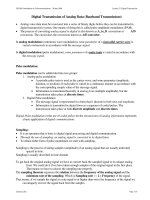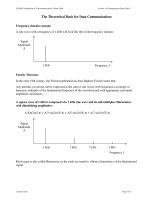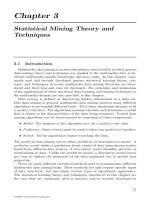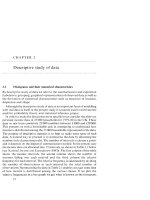administering data centers
Bạn đang xem bản rút gọn của tài liệu. Xem và tải ngay bản đầy đủ của tài liệu tại đây (16.72 MB, 664 trang )
Kailash Jayaswal
Administering
Data Centers:
Servers, Storage,
and Voice over IP
01_77183x ffirs.qxd 10/11/05 6:18 PM Page iii
Administering
Data Centers:
Servers, Storage,
and Voice over IP
01_77183x ffirs.qxd 10/11/05 6:18 PM Page i
01_77183x ffirs.qxd 10/11/05 6:18 PM Page ii
Kailash Jayaswal
Administering
Data Centers:
Servers, Storage,
and Voice over IP
01_77183x ffirs.qxd 10/11/05 6:18 PM Page iii
Administering Data Centers: Servers, Storage, and Voice over IP
Published by
Wiley Publishing, Inc.
10475 Crosspoint Boulevard
Indianapolis, IN 46256
www.wiley.com
Copyright © 2006 by Wiley Publishing, Inc., Indianapolis, Indiana
Library of Congress Control Number: 2005026258
ISBN-13: 978-0-471-77183-8
ISBN-10: 0-471-77183-X
Manufactured in the United States of America
10 9 8 7 6 5 4 3 2 1
1MA/QZ/RR/QV/IN
No part of this publication may be reproduced, stored in a retrieval system, or transmitted in
any form or by any means, electronic, mechanical, photocopying, recording, scanning or
otherwise, except as permitted under Sections 107 or 108 of the 1976 United States Copyright
Act, without either the prior written permission of the Publisher or authorization through
payment of the appropriate per-copy fee to the Copyright Clearance Center, 222 Rosewood
Drive, Danvers, MA 01923, (978) 750-8400, fax (978) 646-8600. Requests to the Publisher for
permission should be addressed to the Legal Department, Wiley Publishing, Inc., 10475 Cross-
point Blvd., Indianapolis, IN 46256, (317) 572-3447, fax (317) 572-4355, or online at http://
www.wiley.com/go/permissions.
Limit of Liability/Disclaimer of Warranty: The publisher and the author make no represen-
tations or warranties with respect to the accuracy or completeness of the contents of this work
and specifically disclaim all warranties, including without limitation warranties of fitness for
a particular purpose. No warranty may be created or extended by sales or promotional mate-
rials. The advice and strategies contained herein may not be suitable for every situation. This
work is sold with the understanding that the publisher is not engaged in rendering legal,
accounting, or other professional services. If professional assistance is required, the services of
a competent professional person should be sought. Neither the publisher nor the author shall
be liable for damages arising herefrom. The fact that an organization or Website is referred to
in this work as a citation and/or a potential source of further information does not mean that
the author or the publisher endorses the information the organization or Website may provide
or recommendations it may make. Further, readers should be aware that Internet Websites
listed in this work may have changed or disappeared between when this work was written
and when it is read.
For general information on our other products and services or to obtain technical support,
please contact our Customer Care Department within the U.S. at (800) 762-2974, outside the
U.S. at (317) 572-3993 or fax (317) 572-4002.
Wiley also publishes its books in a variety of electronic formats. Some content that appears
in print may not be available in electronic books.
Trademarks: Wiley, the Wiley logo, and related trade dress are trademarks or registered
trademarks of John Wiley & Sons, Inc., and/or its affiliates, in the United States and other
countries, and may not be used without written permission. All other trademarks are the
property of their respective owners. Wiley Publishing, Inc., is not associated with any prod-
uct or vendor mentioned in this book.
01_77183x ffirs.qxd 10/11/05 6:18 PM Page iv
Kailash Jayaswal (Campbell, CA) is currently a project manager for Cisco Sys-
tems, Inc. He has more than 18 years of technical experience as a systems and
storage administrator at various companies, such as Caterpillar, Inc., Roche Bio-
science, IBM, Navisite, Siebel, KLA Tencor, and Cisco Systems, Inc. He has
worked extensively with operating systems, servers, networks, and storage
products from Sun, EMC, IBM, VERITAS, Intel, Microsoft, Network Appliance,
and Hewlett-Packard. He has a wealth of hands-on and project-management
experience in deploying storage architectures, large data-center consolidations,
capacity planning, and disaster-recovery design and implementation. Through-
out his career, he has taught several classes on systems administration (HPUX,
Solaris, and AIX), data-center best practices, and server and storage capacity
planning and architecture, using industry-leading products.
About the Author
v
01_77183x ffirs.qxd 10/11/05 6:18 PM Page v
01_77183x ffirs.qxd 10/11/05 6:18 PM Page vi
Executive Editor
Carol Long
Development Editor
Kevin Shafer
Production Editor
William A. Barton
Copy Editor
Publication Services, Inc.
Editorial Manager
Mary Beth Wakefield
Production Manager
Tim Tate
Vice President & Executive Group
Publisher
Richard Swadley
Vice President and Publisher
Joseph B. Wikert
Project Coordinator
Ryan Steffen
Graphics and Production Specialists
Denny Hager
Stephanie D. Jumper
Melanee Prendergast
Alicia South
Quality Control Technician
Leeann Harney
Jessica Kramer
Brian H. Walls
Media Development Specialists
Angela Denny
Kit Malone
Travis Silvers
Proofreading and Indexing
TECHBOOKS Production Services
Credits
vii
01_77183x ffirs.qxd 10/11/05 6:18 PM Page vii
01_77183x ffirs.qxd 10/11/05 6:18 PM Page viii
About the Author v
Preface xxiii
Acknowledgments xxv
Introduction xxvii
How This Book Is Organized xxviii
Key Points xxxiii
Part One Data Center Basics 1
Chapter 1 No Time for Downtime 3
Causes of Downtime 7
Cost of Downtime 10
Key Points 15
Chapter 2 The High-Availability Continuum 17
High-Availability Metrics 19
Availability Choices: How Much Availability Is Enough? 20
Level 1: Depend on Built-in Hardware Reliability 20
Level 2: Data Protection 21
Level 3: Fault-Tolerant Servers 21
Level 4: Server Redundancy or Clustering 21
Level 5: Disaster Recovery 22
Commercial Cluster Management Software 22
Key Points 23
Contents
ix
02_77183x ftoc.qxd 10/11/05 6:18 PM Page ix
Part Two Data Center Architecture 25
Chapter 3 Data Center Requirements 27
Data Center Prerequisites 27
Required Physical Area for Equipment and Unoccupied Space 28
Required Power to Run All the Devices 29
Required Cooling and HVAC 29
Required Weight 30
Required Network Bandwidth 31
Budget Constraints 32
Selecting a Geographic Location 33
Safe from Natural Hazards 33
Safe from Man-Made Disasters 34
Availability of Local Technical Talent 35
Abundant and Inexpensive Utilities Such as Power and Water 35
Selecting an Existing Building (Retrofitting) 35
Key Points 36
Chapter 4 Data Center Design 37
Characteristics of an Outstanding Design 38
Guidelines for Planning a Data Center 38
Data Center Structures 39
No-Raised or Raised Floor 39
Aisles 41
Ramp 41
Compulsory Local Building Codes 41
Raised Floor Design and Deployment 42
Plenum 42
Floor Tiles 42
Equipment Weight and Tile Strength 44
Electrical Wireways 44
Cable Trays 45
Design and Plan against Vandalism 45
Best Practices 46
Data-Center Design Case Studies 46
Celebrity Travels 47
Designer Dresses 48
Key Points 49
Chapter 5 Network Infrastructure in a Data Center 51
Modular Cabling Design 52
Points of Distribution (PODs) 54
Internet Access 55
ISP Network Infrastructure 55
ISP WAN Links 56
Best Practices 57
Key Points 60
x Contents
02_77183x ftoc.qxd 10/11/05 6:18 PM Page x
Chapter 6 Data Center Maintenance 61
Network Operations Center (NOC) 61
Network Monitoring 62
Monitoring Requirements 62
SNMP 62
In-Band and Out-of-Band Monitoring 64
Data-Center Physical Security 64
Data-Center Logical Security 65
Data-Center Cleaning 66
Approved Cleaning Supplies 66
Floor Surface Cleaning 67
Subfloor and Above-Ceiling Plenum Cleaning 67
Equipment Cleaning 67
Best Practices 68
Key Points 69
Chapter 7 Power Distribution in a Data Center 71
Estimating Your Power Needs 71
Uninterruptible Power Supply (UPS) 73
Generators 75
Power Conditioning 76
Single-Phase and Three-Phase Power 76
Power Distribution Units (PDUs) 77
Electrostatic Discharge (ESD) 78
Key Points 78
Chapter 8 Data Center HVAC 79
Reasons for Strict Environmental Requirements 80
Need for Energy-Efficient HVAC Systems 82
Air-Conditioning Systems 83
Cold-Liquid Air-Conditioning Systems 83
Dry Air-Conditioning Systems 83
Air Circulation in a Data Center 86
Placement of Hardware Racks 86
Bottom-to-Top Cooled Racks 87
Top-to-Bottom Cooled Racks 87
Front-to-Front Cooled Racks 87
Front-to-Back Cooled Racks 89
Best Practices 90
Key Points 91
Part Three Data Center Consolidation 93
Chapter 9 Reasons for Data Center Consolidation 95
Reasons for Data Center Consolidation 96
Consolidation Opportunities 97
Server Consolidation 97
Storage Consolidation 98
Contents xi
02_77183x ftoc.qxd 10/11/05 6:18 PM Page xi
Network Consolidation 101
Application Consolidation 103
Service Consolidation 104
Process Consolidation 104
Staff Consolidation 105
Key Points 105
Chapter 10 Data Center Consolidation Phases 107
Phase 1: Study and Document the Current Environment 107
Evaluate Application Requirements 108
Evaluate Hardware Infrastructure 110
Evaluate Storage Requirements 111
Evaluate Networking Requirements 111
Evaluate Operations Requirements 112
Evaluate Risk 112
Phase 2: Architect the Target Consolidated Environment 113
Design Step 1: Analyze the Collected Data 113
Design Step 2: List Architectural Requirements 114
Design Step 3: Create an Initial Architecture 116
Design Step 4: Size All Equipment 116
Design Step 5: Create a Prototype of the Proposed Solution 117
Design Step 6: Test the Prototype 117
Design Step 7: Revise the Proposed Architecture 118
Design Step 8: Document the Proposed Architecture 118
Phase 3: Implement the New Architecture 118
Draft All Low-Level Specifications 119
Construct the New Environment 119
Create a Data Migration Process 120
Back Up Data in the Old Environment 121
Migrate Data and Services to the New Environment 121
Train the Operations Staff 122
Phase 4: Control and Administer the Consolidated
Environment 123
Key Points 125
Part Four Data Center Servers 127
Chapter 11 Server Performance Metrics 129
What Is a Benchmark? 130
Benchmark Organizations 130
Aspects of System Performance 131
Utilization 131
Latency 131
Throughput 131
Efficiency 132
Factors Impacting CPU Performance 132
SPEC Benchmarks 133
SPEC Integer Benchmarks 134
SPEC Floating-Point Benchmarks 135
xii Contents
02_77183x ftoc.qxd 10/11/05 6:18 PM Page xii
SPEC Web Benchmarks 135
SPEC OpenMP Benchmark Suite 135
SPEC NFS Benchmarks 136
SPEC Java Benchmarks 136
SPEC Graphics Benchmarks 136
SPEC Mail Benchmarks 137
Linpack Benchmarks 137
TPC Benchmarks 138
TPC-C 138
TPC-H 139
TPC-R 140
TPC-W 140
Obsolete TPC Benchmarks 141
NotesBench Mail 141
Key Points 142
Chapter 12 Server Capacity Planning 143
Server Sizing and Capacity Planning 144
Identifying the Slowest Link 145
Capacity Planning for Servers 146
Phase 1: Define the Customer’s Requirements 146
Phase 2: Measure or Estimate Current Resource Utilization 148
Phase 3: Size the New Server 151
Key Points 155
Chapter 13 Best Practices in IT 157
Defining Best Practices 158
Deploying Best Practices 159
Benefits of Best Practices 160
Systems Management Best Practices 161
Systems Deployment 161
Power Sources 162
Hardware Maintenance 162
Software Deployment 163
Server Cluster Best Practices 163
Data Storage Best Practices 164
Network Management Best Practices 165
What-If Analysis 165
Baselining and Trending 166
Exception Management 167
Quality of Service Management 167
Network Port Auto-Negotiation 168
Documentation Best Practices 168
Methodology Documents 169
Proposal Documents 169
Event Analysis Documents 170
Technical Documentation 171
Contents xiii
02_77183x ftoc.qxd 10/11/05 6:18 PM Page xiii
Network Diagram Documentation 171
Documentation Formats 172
Key Points 173
Chapter 14 Server Security 175
General Host Security Guidelines 176
UNIX Security Guidelines 177
Internet Security Issues 178
Sources of Information on Security 185
Key Points 185
Chapter 15 Server Administration 187
Best Practices for System Administration 188
System Administration Work Automation 191
What Should Be Automated? 192
Types of Automation 193
Automation Guidelines 193
Common Automation Tools 196
Examples of Automation 199
Key Points 201
Chapter 16 Device Naming 203
Naming Practices 204
NIS 205
NIS+ 206
DNS 207
DNS Caching 210
Registering Your Domain Name in DNS 212
LDAP 212
Designing a Directory Information Tree (DIT) 215
Key Points 216
Chapter 17 Load Balancing 217
Load-Balancing Terminology 218
Advantages 219
Fault Tolerance 219
Service Availability 219
Performance 220
Scalability 220
Flexibility 220
Cost Savings 220
Security 220
Types of Load Balancing 221
Software-Based Methods 221
Hardware-Based Methods 223
Implementing a Network with Load-Balancing Switches 225
Virtual and Real Servers 228
Best Practices for Load Balancing 230
Key Points 231
xiv Contents
02_77183x ftoc.qxd 10/11/05 6:18 PM Page xiv
Chapter 18 Fault Tolerance 233
Need for Fault Tolerance 234
Component Reliability Terms 234
Fault-Tolerant Systems Versus Clusters 235
Fault-Tolerant Disk Subsystems 236
Hot-Swappable and Hot-Spare Drives 236
Cooling Systems 236
Power Supplies 236
Robust Self-Monitoring Enclosures 237
Disk Redundancy Using RAID Levels 237
Redundant Controllers within a Disk Subsystem 238
Host-Based Adapters (HBAs) within a Server 238
Cache in the Subsystem Controller 238
Best Practices 239
Key Points 240
Chapter 19 RAID 241
RAID-0 (Striping) 242
RAID-1 (Mirroring) 243
RAID 0+1 (Mirrored Stripes) 244
RAID 1+0 or RAID 10 (Striped Mirrors) 245
RAID-2 247
Parity-Based RAID (RAID-3, -4, and -5) 247
RAID-3 248
RAID-4 248
RAID-5 249
Key Points 251
Part Five Data Storage Technologies 253
Chapter 20 Data Storage Solutions 255
Rapid Data Growth 256
Data Storage Requirements 258
Storage Access Modes 259
DAS Versus SAN 259
NAS Versus SAN 261
Benefits of SAN 262
Consolidation of Storage Resources 262
Concurrent Access by Multiple Hosts 263
Reduced Total Cost of Ownership (TCO) 263
LAN-Free and Server-Free Data Transfers 263
Maximum Distance between Nodes and Use in Disaster
Recovery Applications 264
High Performance 265
Scalability and Flexibility 266
Server Clustering 267
Applications Best Suited for SAN 267
Contents xv
02_77183x ftoc.qxd 10/11/05 6:18 PM Page xv
Considerations before Designing a SAN 268
Application Requirements 268
Know Your Site 268
Type of Cables and Devices for Your Site 268
Need for Present and Future SAN Features 269
Expected Traffic Volume 269
Distance between Nodes 269
Number of Devices 269
Do You Need to Accommodate Existing Direct-Attached
Components? 270
Cost 270
NAS/SAN Hybrid 270
Key Points 271
Chapter 21 Storage Area Networks 273
What Is a SAN? 273
Fibre Channel (FC) 277
Fiber Cable Connectors 277
Single-Mode Fiber or Multimode Fiber 278
Wavelength Shortwave or Longwave 279
SAN Components 280
SAN Topologies 281
Point-to-Point Topology 281
Fibre Channel–Arbitrated Loop (FC-AL) 283
Switched-Fabric Topology 286
Best Practices 296
Key Points 296
Chapter 22 Configuring a SAN 299
SAN Design Phases 299
Phase 1: Gather Requirements 300
Phase 2: Gather Existing Environment Information 300
Phase 3: Select a Mass Storage Solution 300
Phase 4: Connect Storage and Servers 300
Example of SAN Design Phases 301
SAN Implementation Phases 303
Phase 1: Create Local SANs 303
Phase 2: Build Enterprise-Wide SAN 303
Phase 3: Protect the SAN Data 303
Best Practices for SAN Deployment 307
Key Points 307
Chapter 23 Using SANs for High Availability 309
Configuring an HA SAN 309
Level 1: Path-Level Redundancy 310
Level 2: Switch-Level Redundancy 311
Level 3: Fabric-Level Redundancy 311
xvi Contents
02_77183x ftoc.qxd 10/11/05 6:18 PM Page xvi
Switch Features for Improving
HA and Performance 313
Using SANs to Deploy Campus
or Metropolitan Clusters 314
Key Points 317
Chapter 24 IP-Based Storage Communications 319
Why Use IP Storage? 319
Types of IP Storage 320
iSCSI 320
Fibre Channel over IP (FCIP) 323
Internet Fibre Channel Protocol (iFCP) 325
Extending SAN over ATM, IP, or SONET for
Disaster Recovery 325
Adopting IP Storage 328
Best Practices for IP-Based Storage Networks 328
Key Points 329
Part Six Data Center Clusters 331
Chapter 25 Cluster Architecture 333
Asymmetric Two-Node Clusters 335
Symmetric Two-Node Clusters 336
Complex Cluster Configurations 338
Many-to-One Failover Model 339
One-to-Many Failover Model 340
Any-to-Any Failover Model 340
Failover Policies 341
Failover Pairs 341
N+1 Policy 342
N+M Policy 342
Failover-Ring Policy 342
Random Policy 343
Best Practices 343
Key Points 344
Chapter 26 Cluster Requirements 345
Required Hardware Cluster Components 346
Servers 346
Private (Heartbeat) Networks 346
Administrative (Maintenance) Network 349
Public or Service Network 349
Shared Disks 349
Adapter SCSI ID Requirements 350
Local Disks 351
Cluster Software Requirements 351
System Crash 354
System Hang 354
Contents xvii
02_77183x ftoc.qxd 10/11/05 6:18 PM Page xvii
Planned Maintenance 355
Heartbeat Link Failure 355
Cluster Startup Problems 355
What Happens During Service Failover 356
Ownership of Shared Disks 356
Network Identity 356
Cluster Services 358
Cluster Installation Checklist 358
Key Points 359
Chapter 27 Designing Cluster-Friendly Applications 361
Automating Operations 362
Controlling Application Failover Time 363
Reducing Data Loss During Failover 364
Minimizing Application Failures 365
Designing Node-Independent Applications 365
Minimizing Planned Downtime 366
Restoring Client Connections 367
Key Points 368
Part Seven Network Design, Implementation, and Security 369
Chapter 28 Network Devices 371
Network Devices 371
Hubs Versus Switches 376
Routers 376
Network Cables 381
Coaxial Cables (Copper) 382
Twisted-Pair Cables (Copper) 383
Fiber-Optic Cables (Glass) 383
Key Points 387
Chapter 29 Network Protocols 389
Transmission Control Protocol/Internet Protocol (TCP/IP) 392
TCP and UDP as Transport (Layer 4) Protocols 393
Ports 394
Key Points 395
Chapter 30 IP Addressing 397
Subnet Masks 402
Class C Subnet Masks 405
Class B Subnet Masks 407
IP Version 6 409
Key Points 411
Chapter 31 Network Technologies 413
LAN Technologies 413
Asynchronous Transfer Mode (ATM) 414
Digital Signal (DS) and T and E Carriers 415
xviii Contents
02_77183x ftoc.qxd 10/11/05 6:18 PM Page xviii
Ethernet 416
Fiber Distributed Data Interface (FDDI) 419
Synchronous Optical Network (SONET) or Optical
Carrier (OC) 420
Token Ring 421
Usage Trends 423
WAN Technologies 423
WAN Dial-In Technologies 424
WAN Trunk Technologies 430
Key Points 434
Chapter 32 Network Topologies 435
Architecture-Based Network Topologies 435
Bus Topology 436
Tree Topology 437
Ring Topology 437
Single-Star Topology 437
Hierarchical-Star Topology 438
Wireless Topology 440
Point-to-Point Topology 441
Meshed Topology 441
Distance-Based Network Topologies 442
Local Area Network (LAN) 444
Metropolitan Area Network (MAN) 445
Wide Area Network (WAN) 445
VLAN Concepts 446
Key Points 446
Chapter 33 Network Design 447
Three-Layer Hierarchical Network Design 447
Access Layer 449
Distribution Layer 450
Core Layer 452
Benefits of Hierarchical Design 453
Campus Network Design 453
Host-to-Switch Connection 454
The Switch-to-Router Configuration 456
Network Backbones 457
Switched and Routed Backbones 458
Enterprise Network Design Phases 461
Phase 1: Identify the Customer’s Business and Technical
Objectives 462
Phase 2: Evaluate the Customer’s Current Network 464
Phase 3: Design a New Network Topology 464
Phase 4: Document All Findings and Proposed Design 467
Best Practices for Network Design 468
Key Points 470
Contents xix
02_77183x ftoc.qxd 10/11/05 6:18 PM Page xix
Chapter 34 Designing Fault-Tolerant Networks 471
Importance of Highly Available Networks 471
Implementing High-Availability Networks 472
Availability through Fault-Tolerant Devices 473
Availability through Redundant NICs in a Host 473
Availability through Redundant Network Topologies 476
Best Practices 478
Key Points 480
Chapter 35 Internet Access Technologies and VPNs 481
Virtual Private Networks (VPNs) 483
Remote-Access VPN 485
Site-to-Site VPNs 486
VPN Security 486
Firewalls 486
Encryption 487
Data Integrity 488
IPSec 490
AAA Server 490
Authentication 491
Tunneling 492
Remote-Access Tunneling 493
Site-to-Site Tunneling 493
Key Points 494
Chapter 36 Firewalls 495
DMZ Areas 496
Firewall Rules or Filters 497
What Does a Firewall Protect You From? 500
Global Addresses Can Hide Internal Networks 501
Firewall Best Practices 503
Key Points 503
Chapter 37 Network Security 505
Computer Viruses 506
Internet Worms 507
The Security Philosophy 508
Traffic-Based Security 510
User-Based Security 511
AAA Model 513
Authentication 513
Authorization 514
Accounting 515
AAA Implementations 516
Key Points 516
xx Contents
02_77183x ftoc.qxd 10/11/05 6:18 PM Page xx
Part Eight Disaster Recovery 519
Chapter 38 Disaster Recovery 521
When Bad Things Happen to Good People 522
High Availability (HA) and Disaster Recovery (DR) 524
Five Phases of DR 525
Phase 1: Find the Funds 526
Phase 2: Assess Existing Environment and Risks 527
Phase 3: Create DR Procedures 528
Phase 4: Test the Procedures 528
Phase 5: Adjust Your DR Plan to Site Changes and
Technical Advancements 529
Designing a Disaster-Tolerant Architecture 529
Online Replication Techniques 531
User-Level Replication 531
Software-Based Replication 532
Device Driver–Level Replication 532
Disk-Subsystem Hardware-Based Replication 533
Database Replication 533
Transaction-Based Replication 533
Process-Level State Replication 534
Best Practices 534
Key Points 536
Chapter 39 DR Architectures 537
Campus Clusters 539
Metropolitan Clusters 540
Continental Clusters 541
Key Points 542
Part Nine Future Considerations 543
Chapter 40 Voice over IP and Converged Infrastructure 545
Component 1: Independent Data Networks 546
Component 2: Independent Storage Networks 549
Component 3: Independent Voice Networks 551
Important Telephone- and VoIP-Related Terms 553
Converged Infrastructure 554
Storage over IP (SoIP) 555
Voice over IP (VoIP) 559
Building VoIP Networks 560
Business Case for Voice over IP 565
Issues with VoIP 565
Toward a Complete Enterprise Convergence 567
Hardware Convergence 567
Software Convergence 568
Internal Staff Convergence 568
Vendor Convergence 569
Key Points 569
Contents xxi
02_77183x ftoc.qxd 10/11/05 6:18 PM Page xxi
Chapter 41 What’s Next 571
Network Convergence Technologies 572
Storage Virtualization 572
Embedded Systems 574
InfiniBand (IB) 575
Blade Servers 577
Bluetooth 577
System Area Networks (SANs) 579
Key Points 580
Part Ten Appendix 581
Appendix A Storage and Networking Solutions 583
Glossary 587
Index 601
xxii Contents
02_77183x ftoc.qxd 10/11/05 6:18 PM Page xxii
This book explains technologies deployed within data centers. This includes
facility setup, network configuration, power layout, servers, storage, data-center
consolidation, disaster recovery, and voice over IP (VoIP). It describes data-
center management, such as security, server administration, capacity planning,
clustering, and fault tolerance. The book covers architecture, implementation,
and management details. Implementing high-availability systems, one of the
key topics in this book, is an essential step toward achieving any “always-on”
service.
The book can be used in various ways:
■■
It can serve as an introduction to the myriad of technologies deployed
within a data center.
■■
It can be used as a reference by various professionals such as Informa-
tion Technology (IT) managers, data center facilities teams, system
administrators, database administrators, network managers, security
implementers, and general data center personnel. The chapters can be
chosen in any order and read at any time.
■■
It can be used as material for various Masters in Business Administra-
tion (MBA) courses on IT Management or IT Operations management.
All basic, evolving, and advanced IT technologies are covered here.
This material can be used with more specific information to challenge
the highly experienced MBA student.
■■
This book can be used by system and storage administrators, as well
as IT managers, to build resiliency and high-availability into their
environment.
Preface
xxiii
03_77183x fpref.qxd 10/11/05 6:18 PM Page xxiii









